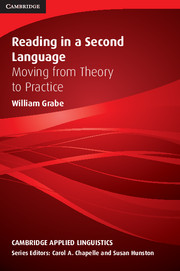Book contents
- Frontmatter
- Contents
- Series editors' preface
- Preface
- I FOUNDATIONS OF READING
- II PATTERNS OF VARIATION IN READING
- III DEVELOPING READING COMPREHENSION ABILITIES
- IV EXPANDING READING COMPREHENSION SKILLS
- Chapter 14 Reading fluency, reading rate, and comprehension
- Chapter 15 Extensive reading
- Chapter 16 The reading curriculum and instruction
- Chapter 17 Reading assessment
- Chapter 18 Further topics and issues in reading
- References
- Author Index
- Subject Index
Chapter 15 - Extensive reading
from IV - EXPANDING READING COMPREHENSION SKILLS
Published online by Cambridge University Press: 05 August 2012
- Frontmatter
- Contents
- Series editors' preface
- Preface
- I FOUNDATIONS OF READING
- II PATTERNS OF VARIATION IN READING
- III DEVELOPING READING COMPREHENSION ABILITIES
- IV EXPANDING READING COMPREHENSION SKILLS
- Chapter 14 Reading fluency, reading rate, and comprehension
- Chapter 15 Extensive reading
- Chapter 16 The reading curriculum and instruction
- Chapter 17 Reading assessment
- Chapter 18 Further topics and issues in reading
- References
- Author Index
- Subject Index
Summary
We found that amount of engaged reading predicted reading achievement on the National Assessment of Educational Progress (NAEP). Students who read independently for enjoyment, take books from libraries, and read for substantial amounts of time are relatively higher in achievement.
(Guthrie, Schafer, & Huang, 2001: 159)Research evidence suggests that the actual amount of time children spend reading in the average classroom is small, perhaps as little as seven or eight minutes per day at the primary level and 15 minutes per day at the middle grade level.
(Guthrie & Greaney, 1991: 80.)The ability to read extended texts for long periods of time is a hallmark of fluent reading. No other set of reading activities or reading practice can substitute for reading a longer text with reasonable comfort and without needing to stop constantly, and without feeling fatigued or overwhelmed. It actually is an extraordinarily difficult feat to accomplish for a nonfluent reader, and it usually requires that a reader know 98–99 percent of the words in a text (three to six unknown words on a 300-word page). It requires some level of fluency and efficiency in processing words and sentences. It necessitates some awareness of how texts are structured. It assumes that commonly used strategies are carried out as a matter of routine. It also assumes reasonably efficient inferencing, monitoring, and evaluation skills; motivation to persist; and prior experiences of success with extended reading. In all these respects, extended reading is a unique skill and imposes unique task requirements. Because of its fluency requirement and time-constrained processing demands, it is also an ability that develops incrementally over a long period of time (involving implicit learning, Chapter 4).
- Type
- Chapter
- Information
- Reading in a Second LanguageMoving from Theory to Practice, pp. 311 - 328Publisher: Cambridge University PressPrint publication year: 2008

